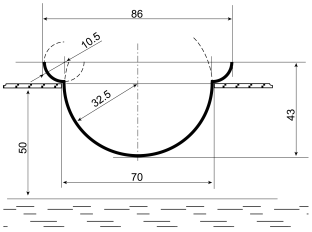Appendix X M. Essential Oils
Fatty Oils and Resinified Essential Oils in Essential Oils
Allow 1 drop of the essential oil to fall onto filter paper. The drop evaporates completely within 24 h without leaving any translucent or greasy spot.
Foreign Esters in Essential Oils
Heat 1 mL of the essential oil for 2 min on a water-bath with 3.0 mL of a freshly prepared 100 g/L solution of potassium hydroxide R in alcohol R. No crystals are formed within 30 min, even after cooling.
Odour and Taste of Essential Oils
Mix 3 drops of the essential oil with 5 mL of alcohol (90 per cent V/V) R and stir in 10 g of powdered sucrose R. The odour and taste are similar to that of the plant or parts of the plant from which the essential oil has been obtained.
Residue on Evaporation of Essential Oils
The residue on evaporation of an essential oil is the percentage by mass of the oil which remains after evaporation on a water-bath under the conditions specified below.
Apparatus The apparatus (see Figure 2.8.9.-1) consists of:
Method Weigh the evaporating dish after having heated it on the water-bath for 1 h and cooled it in the desiccator. Weigh into the evaporating dish 5.00 g of the essential oil, unless otherwise prescribed. Heat the oil on the vigorously boiling water-bath in a draught-free atmosphere for the prescribed time. Allow to cool in the desiccator and weigh.
During the test, the level of water in the bath is maintained about 50 mm beneath the level of the cover.
Solubility in Alcohol of Essential Oils
Place 1.0 mL of the essential oil in a 25 mL or 30 mL glass-stoppered cylinder. Place in a constant temperature device, maintained at a temperature of 20 ± 0.2 °C. Using a burette of at least 20 mL capacity, add the alcohol of the strength prescribed in the monograph by increments of 0.1 mL until solution is complete and then continue adding by increments of 0.5 mL to a total of 20 mL, shaking frequently and vigorously. Record the volume of alcohol added when a clear solution has been obtained and, if the solution becomes cloudy or opalescent before 20 mL of alcohol has been added, record the volume added when the cloudiness or opalescence appears and, where applicable, the volume added when the cloudiness or opalescence disappears.
If a clear solution has not been obtained when 20 mL of alcohol of the prescribed strength has been added, repeat the test using the next highest concentration of alcohol.
An essential oil is said to be “soluble in n volumes and more of alcohol of given strength t” when the clear solution in n volumes remains clear when compared with the undiluted oil after further addition of alcohol of the same strength up to a total of 20 volumes of alcohol.
An essential oil is said to be “soluble in n volumes of alcohol of given strength t, becoming cloudy when diluted” when the clear solution in n volumes becomes cloudy in n1 volumes (n1 less than 20) and stays so after further gradual addition of alcohol of the same strength up to a total of 20 volumes of alcohol.
An essential oil is said to be “soluble in n volumes of alcohol of given strength t with cloudiness between n1 and n2 volumes” when the clear solution in n volumes becomes cloudy in n1 volumes (n1 less than 20) and stays so after further gradual addition of alcohol of the same strength up to a total of n2 volumes of alcohol and then becomes clear (n2 less than 20).
An essential oil is said to be “soluble with opalescence” when the alcoholic solution shows a bluish tinge, similar to that of a standard of opalescence freshly prepared as follows: mix 0.5 mL of silver nitrate solution R2 and 0.05 mL of nitric acid R; add 50 mL of a 12 mg/L solution of sodium chloride R; mix and allow to stand protected from light for 5 min.
Water in Essential Oils
Mix 10 drops of the essential oil with 1 mL of carbon disulfide R. The solution remains clear on standing.
